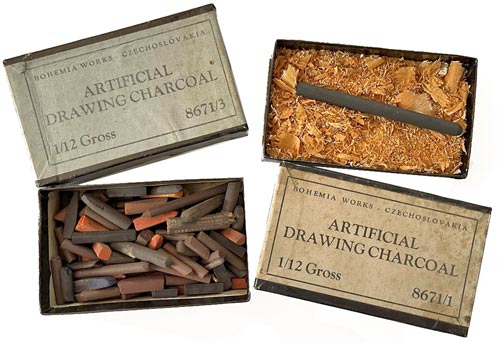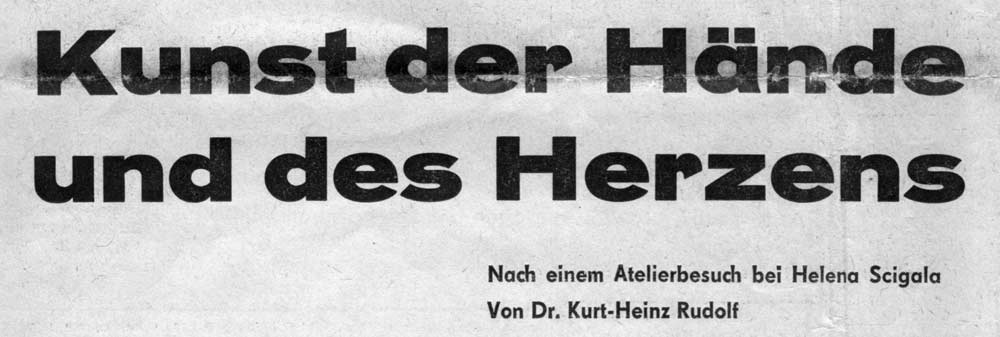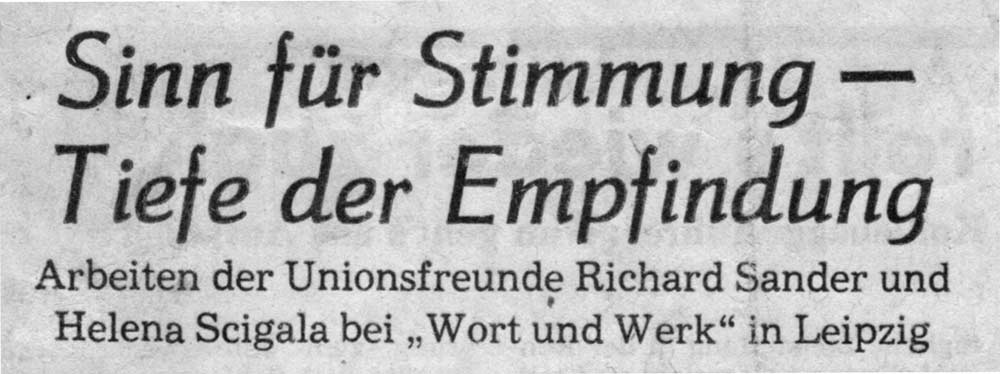
Media Coverage (Selection, chronological)
+++ Headlines +++ Quotes +++
(Rights remain with the respective publications)
Mention of the artist on the occasion of a sales exhibition in Berlin-Pankow
Sonntag. Weekly newspaper for cultural politics, art and science; December 16, 1956:
Print collectors and art lovers […] should note the outstanding lithographs and woodcuts by René Graetz, Paul Schultz-Liebisch, Helena Scigala and Franz Stock in [Berlin-]Pankow.
Introduction of the artist on the occasion of an exhibition for International Women's Day 1957 at the House of the Cultural Association in Berlin-Pankow
Alfred Koch: Women as Artists, March 1957:
Helena Scigala impresses with chalk drawings […] and her "Old Woman" (woodcut) with furrowed face above worn-out hands […] Memories of the unforgettable Kollwitz's figures are awakened.
Three reports on Helena Scigala's solo exhibition in spring 1959 at the art bookstore "Deutsche Bücherstube" in Berlin-Mitte
Nationalzeitung, March 25, 1959:
Helena Scigala's art possesses a feminine, maternal, sensitive manner that reveals human and artistic affection for the child, the mother, the girl. [...] Helena Scigala is a strong graphic talent.
Berliner Zeitung, April 9, 1959:
The thirty prints in the small exhibition provide a beautiful insight into the sovereign mastery of various graphic techniques, be it drawing, etching, woodcut, or her special specialty, the color woodcut.
Neue Zeit, April 19, 1959:
Helena Scigala's art has something dark, mysterious; it is not loud and talkative, but permeated with a sincere love for people.
Introduction of the artist in a monograph
Hannelore Sachs: Helena Scigala. Portrait of an Artist, Berlin 1960, p. 7:
With a primitive, ornamentally painted cigarette case made from X-ray plates, she passed the provisional entrance examination [at the Berlin-Weissensee School of Art].
ibid., p.14:
It is a self-contained world that is shaped in the large-format woodcuts with expressive and decorative means. Her sensitivity is directed more toward the inner richness of experience than toward external events. […] Where the threat to humans, but especially to children, is concerned, she raises her voice, which otherwise prefers the quiet and subdued tone.
Justification of the jury of the CDU graphic competition 1960 for awarding Helena Scigala's contribution "Ravensbrück Cycle" with the 3rd prize
In a stirring, expressive visual language, you depict the suffering of women and children in the Ravensbrück concentration camp. You incorporate graphic elements originating from Käthe Kollwitz into your quite idiosyncratic and personal conception.
Report on the opening of Helena Scigala's solo exhibition on April 20, 1963, in the so-called Art Cabinet in Berlin-Weissensee (Institute for Teacher Further Education)
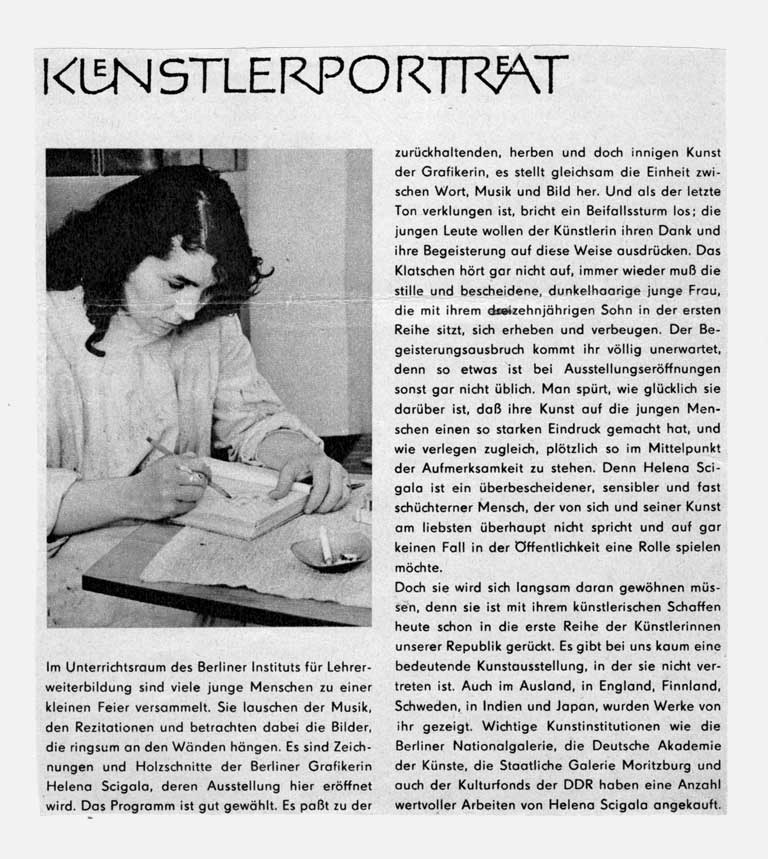
Introduction of the artist, publication unknown
Dr. Edith Krull: Helena Scigala, 1963, pp. 22-26, p. 26:
Helena Scigala's artistic development spans barely fifteen years. During this time, in a constantly ascending line, she has already created a remarkable body of work […] The now forty-two-year-old graphic artist is on an upward path that promises much more from her.
Report on a special exhibition of the CDU with award-winning works in Erfurt
Neue Zeit, after September 29, 1964:
The works of the winners in the Graphic Competition [of the CDU] were on display during the 11th Party Congress in a special exhibition at the traditional [...] Erfurt Anger Museum. [...] The strongest impressions among the award-winning works came from Helena Scigala's Albert Schweitzer cycle. The Berlin graphic artist – who had already successfully participated in the competition for the 10th Party Congress – created three woodcut portraits [...] The mastery of composition and image structure is as convincing in these three prints as the intellectual penetration that captures the innermost nature of Albert Schweitzer.
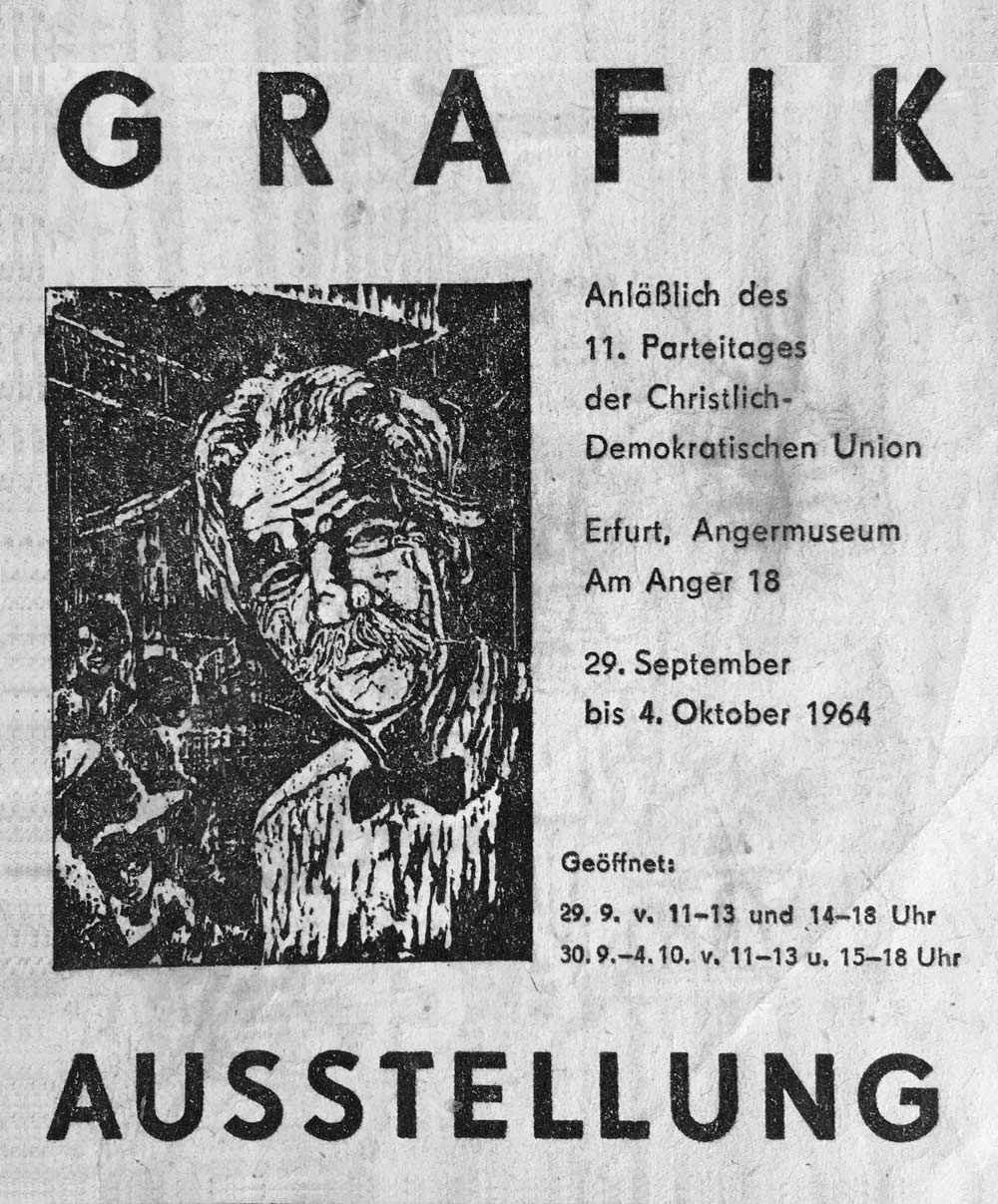
Introduction of the artist on the radio (documented as a corrected manuscript)
Radio contribution by Fritz Dieckmann: Visit to the graphic artist Helena Scigala, 1964:
Since the 1950s, the artist has lived [...] in Berlin, working freelance in her graphic art; her reputation, to speak with Robert Musil, is "not loud, but strong"; the Academy of Arts has purchased many of her works and sent them around the world (to England, Finland, Sweden, India, Japan), the State Galleries in Berlin and Halle-Moritzburg own prints by her, and on May 1st at the Book Bazaar on Karl-Marx-Allee, the many friends who have acquired her art at numerous exhibitions in the [GDR] capital crowd around her stand.
Introduction of the artist within a youth book
Eva Herbig: Visit to the Studio: Helena Scigala, in: Ilse Ploog (Editor): The Magic Chest. An Almanac for Young Girls, Berlin 1965 (Volume 11), pp. 97-103, pp. 99f.:
[From] the conversation with one of our most well-known and accomplished young graphic artists. [...] Helena Scigala is a very sensitive and modest person who does not like it when much is said about herself. [...] She wants her artistic works to communicate with people; she herself wants to remain in the background. [...] She would certainly object if she heard it; but in her quiet, friendly-cheerful manner, she is actually a genuine role model for how a person who is convinced of being able to achieve something in a very specific field asserts herself despite all resistance.
ibid., p.102:
[...] here leads a direct path to the portrait of Anne Frank, one of Helena Scigala's most well-known woodcuts. It is again characterized by the deep compassion of the artist, who intensively immersed herself in all literary sources and testimonies to form a mental image, before transforming it into a visually tangible work.
Introduction of the artist within an anthology
Wolfgang Hütt: Helena Scigala, in: Ibid.: Young Visual Artists of the GDR. Sketches on the Situation of Art in Our Time [a total of 15 texts, including contributions on Willi Sitte and Walter Womacka], Leipzig 1965, pp. 124-134, pp. 128f.:
The moving aspect of the series of drawings that Helena Scigala created about the suffering of the prisoners and the atrocities of the executioners in the Ravensbrück concentration camp is that she always tried to shape an individual fate. She deeply sympathized with it during her work on the sheets.
ibid., p. 129:
The love contained in Helena Scigala's art may perhaps seem a little sentimental. It is nevertheless true to life because it sees brother and sister in human beings. For the sake of this love, Helena Scigala's art is close to us; for the sake of this love, she settled accounts with fascism; for the sake of this love, she shows what is human. [...] She wants that in the world, no more suffering is inflicted on people by people. Therefore, she belongs to us, and her art moves us.
ibid., pp. 131f.:
The first colored prints were created in 1957. Since then, she has pushed back the initial colorfulness and disciplined the form. Although she often prints the color woodcut with six plates, she increasingly succeeded in subordinating the possible richness of colors to dominant chords. [...] Since then, Helena Scigala has steadily checked her formal ideas against reality and has achieved a stronger expressiveness. Her drawing style became richer; she was able to differentiate more. But to this day, she has retained the possibility of showing something of the struggle with the material in the woodcut, which creates a peculiar aesthetic appeal.
ibid., p. 134:
Helena Scigala's art is an absorption of life with knowing seriousness that still knows wonder, full of quiet joy that creates a soft, happy smile around the mouth and tempts the hands to tenderly caress the beautiful and the good.
Publication of the portrait of Anne Frank in a GDR reader
VOLK UND WISSEN, People's Own Publishing House, Department of German Instruction; Berlin, September 13, 1968:
Dear Mrs. Scigala! You were so kind at the time to make your graphic "Anne Frank" available to us for a new reader for the 7th grade. The finished book is now available, and we are sending you a copy enclosed. [...]
Introduction of the artist within a monthly magazine
Lothar Lang: Female Artists, in: The Magazine, March 1976, pp. 53-58. [In this article, a total of 10 female artists were introduced, including Scigala's companions Lea Grundig, Nuria Quevedo and Elizabeth Shaw.] pp. 56f.:
Helena Scigala – let's now set birth dates aside! – once a student of Arno Mohr, has primarily emerged with sensitive woodcuts, the best of which refer to the tradition of late, subdued expressionism.
Report on the commission for the Music School Berlin-Pankow
Neue Zeit, December 24, 1979:
How intensely Helena Scigala is connected to music is particularly felt by the viewer from her newest works. The commission was to create portraits of composers and artists for the rooms of the music school being established in Pankow. [...] The study of old photos and pictures and a deep knowledge of the works resulted in large-scale chalk and sepia drawings with her own interpretation. [...] the sensitive picture of a young flutist and a sheet that could simply be called "Music," a darkly inclined head, the outline of a violin, the suggestion of some musical notation lines [...] The richness of these various expressive musician portraits would soon deserve a separate exhibition.
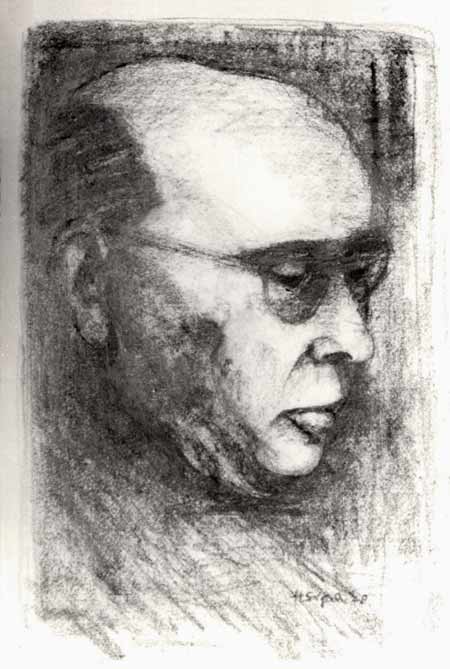
Introduction of the artist within an anthology
Erika A. Lehmann: Helena Scigala, in: Ibid. (Editor): Commission and Concern II. Thirteen Artists' Paths Here and Today, Berlin 1981, pp. 181-194, p. 194:
She tells of a work for a Berlin restaurant. An eight-meter-long wooden frieze, two meters high, was created under the theme: "Russian Folklore." The work was fun for her but physically incredibly strenuous. Her hands hurt, were totally raw. Sitting on the S-Bahn, she suddenly notices the fixed gaze of a well-groomed lady on these hands. With composure, she places both visibly spread out on her lap and looks the person opposite in the eyes.

Catalog contribution for and report on an exhibition of 16 Berlin artists from the field of painting and graphics in the gallery of the Berlin Television Tower [Among the artists was also Helena Scigala's companion Harry Lüttger]
Mimosa Künzel: Helena Scigala, in: Cultural Editorial Berlin (Editor): Berlin Studio 1983. Painting. Graphics. 3, Exhibition catalog for the exhibition at the Television Tower 01/20-02/27/1983, Berlin 1983, pp. 60-64, p. 62:
The graphic work of the Berlin artist Helena Scigala spans three decades of creation. [...] In her works, designed with an unmistakable handwriting, in which she makes no compromises whatsoever, her surroundings, her affection for all creatures, but also world events have always been reflected. [...] The often-cited elective affinity to Käthe Kollwitz lies in the intensity of maternally engaged feeling and their energetic partisanship. Both tried, with their documentary art, to come to the aid of tormented fellow human beings with full care or to set a monument. [...] All her portraits stand out from the portrayed, are reduced to what is essential for her, are an enhancement to the universally valid. With her woodcuts, she literally does heavy work; despite her inclination toward large formats, she has always printed her sheets by hand. At exhibitions all over the world, her works also proclaimed the artistic creation in our country; many of them hang in our galleries.
Neues Deutschland, February 10, 1983:
Depictions of people are only occasionally found in this selection. But it is precisely this small amount that deserves special emphasis. [...] Helena Scigala demonstrates her powerful art of characterization with some generously rendered children's portraits as well as three woodcut portraits (including "Albert Schweitzer") and the monotype "Hungarian Farmer."
Tribute on the 65th birthday of the artist
Neue Zeit, March 1, 1986:
This is the impressive aspect of her work, which has grown over more than three decades: It is of an almost timeless immediacy, permeated with feeling and warmth, and reveals sincerity above all. [...] Helena Scigala has also demonstrated her skill in commissioned works. For the restaurant "Baikal" at Berlin's Lenin Square, she made an eight-meter-long larch wood plate into which she cut scenes from Russian folklore and from folk life in relief. Large chalk and sepia drawings, depicting personalities from music history, she created for the design of the Pankow Music School. In these portraits of Brahms, Eisler, Clara and Robert Schumann, as well as Paul Dessau, she put all her love for music [...].
